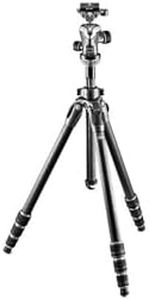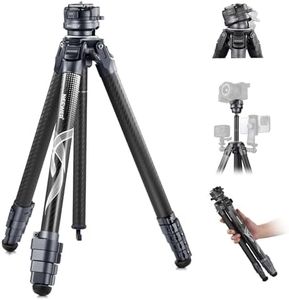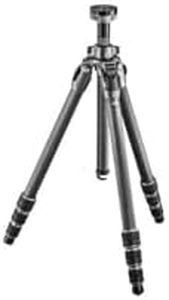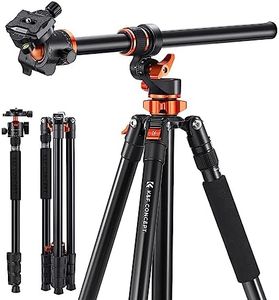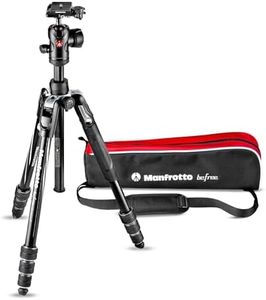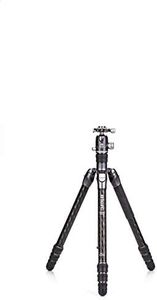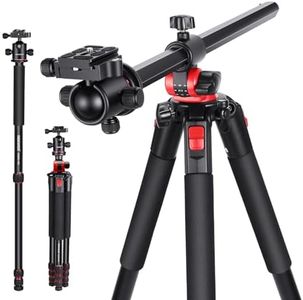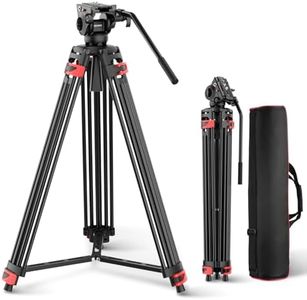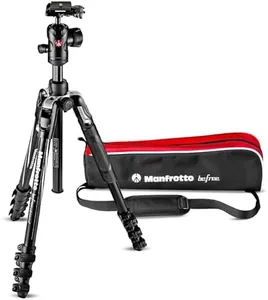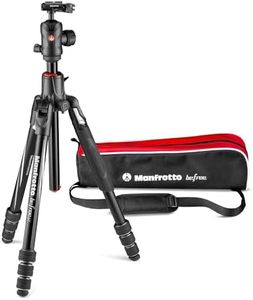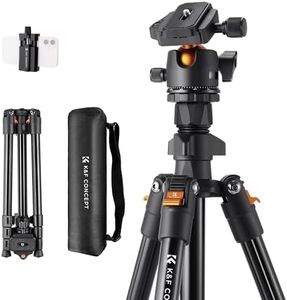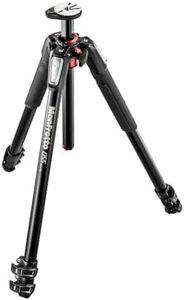We Use CookiesWe use cookies to enhance the security, performance,
functionality and for analytical and promotional activities. By continuing to browse this site you
are agreeing to our privacy policy
10 Best Camera Tripods
From leading brands and best sellers available on the web.Buying Guide for the Best Camera Tripods
Choosing the right camera tripod can greatly improve your photography or videography experience by providing stability, flexibility, and convenience. It's important to consider how, where, and with what equipment you'll use your tripod, as these factors determine which features will be most beneficial for you. Understanding each key specification can help you narrow down your choices and select a tripod that matches your needs and shooting style.MaterialThe material of a tripod affects its weight, durability, and cost. Common materials include aluminum, which is sturdy and affordable but usually heavier, and carbon fiber, which is lighter and resists vibrations better but tends to be more expensive and can be less sturdy in very heavy use. Plastic tripods are lightweight and inexpensive but may not provide enough stability for many cameras. If you plan to travel a lot or hike with your tripod, a lightweight material is helpful. For stationary, studio use, a heavier tripod may be better for stability.
Maximum Load CapacityLoad capacity tells you how much weight the tripod can support without risking stability or breaking. It's crucial because using a tripod beyond its capacity can lead to shaky shots or damage. Load capacities are usually divided into lightweight (good for phones or compact cameras), medium (suitable for mirrorless and beginner DSLRs), and heavy-duty (for professional DSLRs and large lenses). Always choose a tripod that can hold more than the combined weight of your camera and heaviest lens or accessory.
Maximum and Minimum HeightMaximum height is the tallest the tripod reaches when fully extended, while minimum height refers to how low it can go with its legs and center column adjusted. The right heights depend on the kind of photography you do. Taller tripods are useful for eye-level shots and flexibility, while lower minimum heights are helpful for macro or ground-level photography. Think about the kinds of photos you take most often, such as landscapes or tabletop work, and choose a tripod that offers the necessary range.
Leg Lock MechanismLeg locks hold the tripod legs in place and come in two main types: flip locks and twist locks. Flip locks are easy to operate quickly, making them suitable for fast setup, while twist locks offer a sleeker design and can be more reliable in dusty or sandy conditions. If you value speed, flip locks may be a better fit, but for durability and smoothness, twist locks might be preferable. Try both types if possible to see which feels more comfortable for you.
Tripod Head TypeThe head is where you mount your camera and controls its movement. There are several head types, such as ball heads (allow flexible, quick movement), pan-and-tilt heads (offer precise, separate control over different axes), and fluid heads (smooth video panning). If you do both photography and videography, a fluid or pan-and-tilt head might be best. Ball heads are simple and fast for most still photography. Consider how much control and smoothness you want when positioning your camera.
PortabilityPortability refers to how easy it is to carry your tripod, often determined by its weight, fold-down size, and included carrying case. If you'll be carrying your tripod for long distances or traveling, a compact and lightweight design is beneficial. But for studio or fixed-location shooting, portability is less important. Think about how often you’ll move with your gear to decide the importance of compactness and included travel features.
Stability FeaturesTripods may have extra stability options, such as spiked feet for outdoor use, rubber feet for indoors, a center hook for adding weight, or independently adjustable legs for uneven ground. These features help keep your camera steady in different environments. Consider the places you'll shoot most often: if outdoors, spiked feet and a hook can be handy; if indoors, look for non-marking rubber feet. The more diverse your shooting situations, the more versatile your tripod should be in this area.
